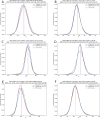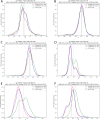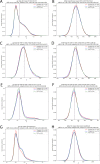How peptide/MHC presence affects the dynamics of the LC13 T-cell receptor
- PMID: 30804417
- PMCID: PMC6389892
- DOI: 10.1038/s41598-019-38788-0
How peptide/MHC presence affects the dynamics of the LC13 T-cell receptor
Abstract
The interaction between T-cell receptors (TCRs) of T-cells and potentially immunogenic peptides presented by MHCs of antigen presenting cells is one of the most important mechanisms of the adaptive human immune system. A large number of structural simulations of the TCR/peptide/MHC system have been carried out. However, to date no study has investigated the differences of the dynamics between free TCRs and pMHC bound TCRs on a large scale. Here we present a study totalling 37 100 ns investigating the LC13 TCR in its free form as well as in complex with HLA-B*08:01 and different peptides. Our results show that the dynamics of the bound and unbound LC13 TCR differ significantly. This is reflected in (a) expected results such as an increased flexibility and increased solvent accessible surface of the CDRs of unbound TCR simulations but also in (b) less expected results such as lower CDR distances and compactness as well as alteration in the hydrogen bond network around CDR3α of unbound TCR simulations. Our study further emphasises the structural flexibility of TCRs and confirms the importance of the CDR3 loops for the adoption to MHC.
Conflict of interest statement
The authors declare no competing interests.
Figures







Similar articles
-
MHC binding affects the dynamics of different T-cell receptors in different ways.PLoS Comput Biol. 2019 Sep 9;15(9):e1007338. doi: 10.1371/journal.pcbi.1007338. eCollection 2019 Sep. PLoS Comput Biol. 2019. PMID: 31498801 Free PMC article.
-
Quantifying conformational changes in the TCR:pMHC-I binding interface.Front Immunol. 2024 Dec 2;15:1491656. doi: 10.3389/fimmu.2024.1491656. eCollection 2024. Front Immunol. 2024. PMID: 39687625 Free PMC article.
-
Conformational flexibility of a free and TCR-bound pMHC-I protein investigated by long-term molecular dynamics simulations.BMC Immunol. 2022 Jul 29;23(Suppl 1):36. doi: 10.1186/s12865-022-00510-7. BMC Immunol. 2022. PMID: 35902791 Free PMC article.
-
A structural voyage toward an understanding of the MHC-I-restricted immune response: lessons learned and much to be learned.Immunol Rev. 2012 Nov;250(1):61-81. doi: 10.1111/j.1600-065X.2012.01159.x. Immunol Rev. 2012. PMID: 23046123 Review.
-
Structural and dynamic control of T-cell receptor specificity, cross-reactivity, and binding mechanism.Immunol Rev. 2012 Nov;250(1):10-31. doi: 10.1111/j.1600-065X.2012.01165.x. Immunol Rev. 2012. PMID: 23046120 Review.
Cited by
-
MHC binding affects the dynamics of different T-cell receptors in different ways.PLoS Comput Biol. 2019 Sep 9;15(9):e1007338. doi: 10.1371/journal.pcbi.1007338. eCollection 2019 Sep. PLoS Comput Biol. 2019. PMID: 31498801 Free PMC article.
-
Characterization of amino acid residues of T-cell receptors interacting with HLA-A*02-restricted antigen peptides.Ann Transl Med. 2021 Mar;9(6):495. doi: 10.21037/atm-21-835. Ann Transl Med. 2021. PMID: 33850892 Free PMC article.
-
Methods for sequence and structural analysis of B and T cell receptor repertoires.Comput Struct Biotechnol J. 2020 Jul 17;18:2000-2011. doi: 10.1016/j.csbj.2020.07.008. eCollection 2020. Comput Struct Biotechnol J. 2020. PMID: 32802272 Free PMC article. Review.
-
Enhanced T cell receptor specificity through framework engineering.Front Immunol. 2024 Mar 12;15:1345368. doi: 10.3389/fimmu.2024.1345368. eCollection 2024. Front Immunol. 2024. PMID: 38545094 Free PMC article.
-
Can Glycosylation Mask the Detection of MHC Expressing p53 Peptides by T Cell Receptors?Biomolecules. 2021 Jul 19;11(7):1056. doi: 10.3390/biom11071056. Biomolecules. 2021. PMID: 34356680 Free PMC article.
References
-
- Kalyaanamoorthy S, Chen YP. Modelling and enhanced molecular dynamics to steer structure-based drug discovery. Prog. Biophys. Mol. Biol. 2014;114(3):123–136. - PubMed
-
- Sledz P, Caflisch A. Protein structure-based drug design: from docking to molecular dynamics. Curr. Opin. Struct. Biol. 2018;48:93–102. - PubMed
Publication types
MeSH terms
Substances
LinkOut - more resources
Full Text Sources
Research Materials
Miscellaneous

